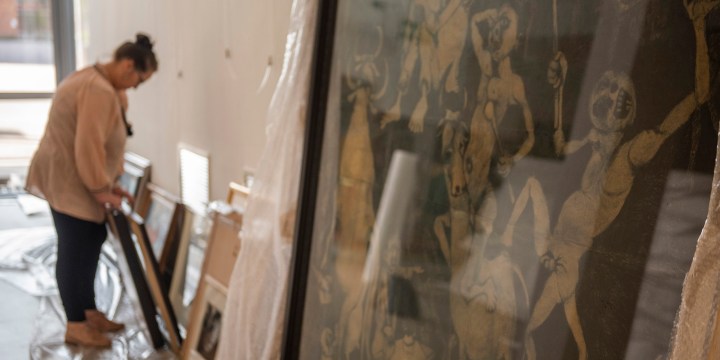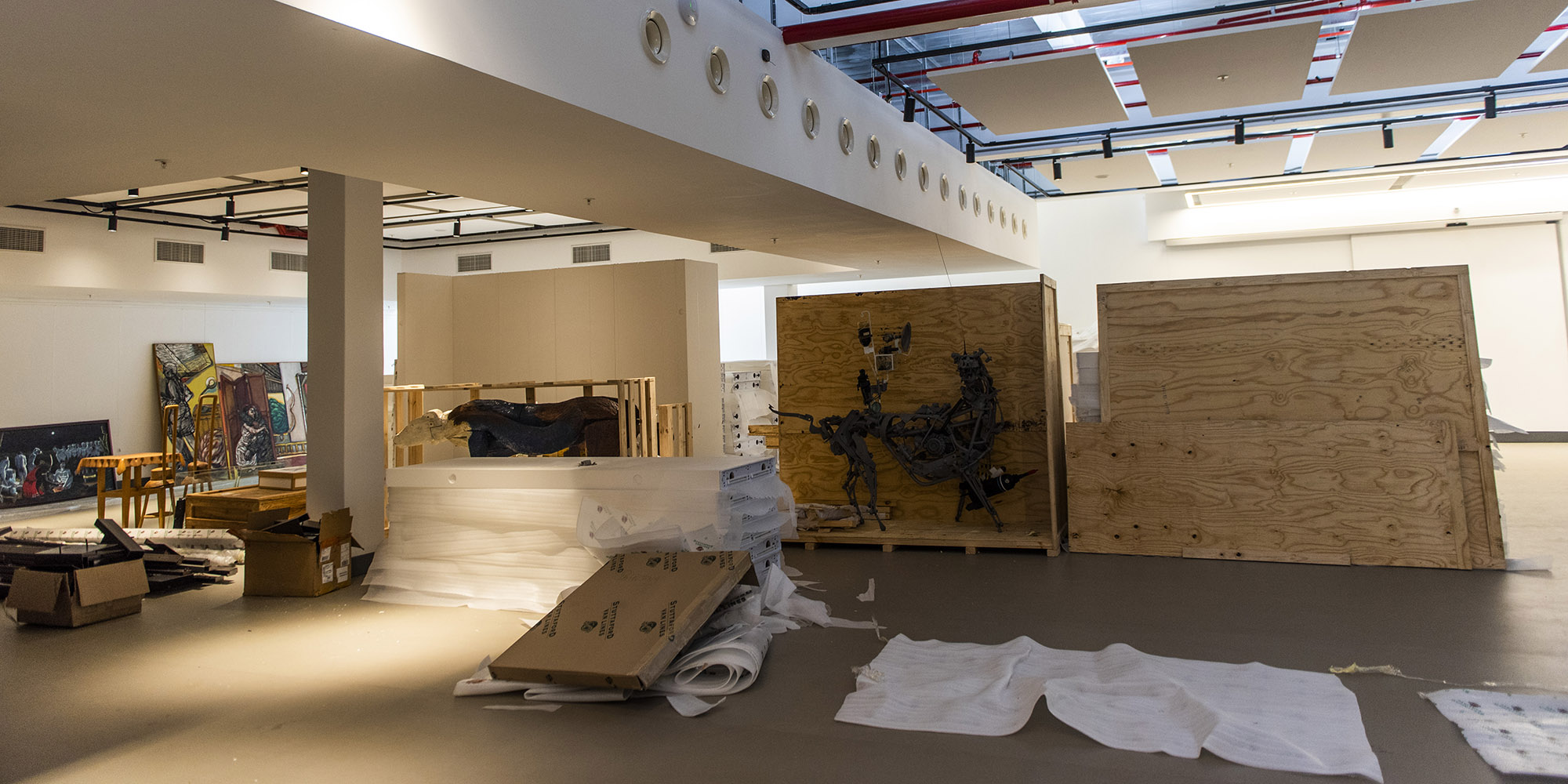ART
New art gallery in Pretoria pulls together an extraordinary collection of South African art

An exciting new privately funded arts facility opens in Pretoria on Heritage Day, pulling together some great opening exhibitions to set a high bar for the future.
The new Javett Art Centre at the University of Pretoria is about to open – on 24 September 2019 – and we are talking to its director, Christopher Till, as we walk through the galleries, before we sit for a bit in his office. Till seems preternaturally calm, like a cheerful Zen Buddhist monk replete with contentment, even as newly delivered artworks for the opening exhibition are being unwrapped and placed on the floor in designated locations.
Till should be tense, even agitated, his face a perpetual frown, what with so much left to be done, so much work planned for display that is not even in the building. The special museum display lights are not installed, let alone focused appropriately on the works to be showcased.

(Photo supplied)
Instead, he stands there calm, happy, smiling. He must be seeing the whole of it, complete, the rooms filled with crowds, all in his mind’s eye, virtually willing the actual centre and everything in it to fall into place.
The Javett Art Centre is poised to become a new artistic chapter for the capital, for Gauteng province, and the country as a whole. Historically, the two big cities of Johannesburg and Pretoria have had their main (but now financially deeply stressed) civic-run art museums, plus an array of small private galleries offering the new and the old, the decorative and the challenging, for sale to the collecting public.
But, beyond the Wits Arts Museum in Braamfontein, Johannesburg – effectively carved out of an old dental school building a few years ago – or, more modestly, the Centre for the Less Good Idea in Maboneng, designed as a staging area for multidisciplinary arts projects, the economic, financial and political core of South Africa has had no new institutional structures designed to challenge preconceptions about art. Such galleries should help people question whose art it really is hanging on the walls of museums and galleries in South Africa.
Into the complex landscape, this new Javett Art Centre is a distinctly welcome project. It has been conceived to be the new home for a large, privately owned collection of South African art, assembled by businessman Michael Javett and his family, with the assistance of the late art dealer Stephan Welz. Describing this centre, Till proudly says it will be “a beautiful, world-class centre where art brings people together. It’s our Africa and our art.”
For the centre’s grand opening, there will be four exhibitions: a collection of 101 signature works of South African art selected and then borrowed from collections around the country; the Javett Family Collection of South African modern art; an exhibition of those special gold works from the Mapungubwe collection; and what has been described as a selection of quirky objects from the university’s other museums.
Till, of course, is an old hand at bringing a cultural project to life – from a “what if” luncheon straight through to the opening day. When this writer first met him, he was running the Zimbabwe National Gallery, back in the late 1980s. Thereafter he returned to South Africa to head the Johannesburg Art Gallery and thereafter to lead the arts and culture office for the City of Johannesburg, just as the country’s cultural isolation was drawing to a close.
Taking advantage of that special moment in time, he led the city into the partnership that hosted the month-long stay of the Dance Theatre of Harlem in Johannesburg, and then to the launch of the Johannesburg Biennale. Thereafter, he moved to establish the internationally renowned Apartheid Museum, and then the Gold of Africa Museum in Cape Town. And now, for the past three years, he has been focused on this newest adventure, bringing the Javett Art Centre to life.
Or, as art entrepreneur Kathy Berman observed, after seeing all the works installed or hung for the opening exhibit, “The key connector in all of this is founding director and curator, Christopher Till, under who the Neglected Tradition at the Joburg Art Gallery where he was director in the 1980s, exposed the art world to artists who were still considered ‘craftspeople ‘ – Jackson Hlungwane, Maria Mabasa, Johannes Maswanganyi and others. Till went on to curate and direct the Apartheid Museum, the Gold of Africa Museum and the Mandela Capture Site in Howick, with that iconic sculpture by Marco Cianfanelli – the maquette of which is also at the Javett.
“While Mandela’s face was rendered invisible during Apartheid, our people were silenced. With the founding exhibition of 101 works, some of our most significant works from the 1980s become true testimonies to the horrors of the Apartheid State, and the power of our artists to voice the cries of those rendered voiceless. The visceral sculpture by Michael Goldberg, Monument to a Migrant Worker, is located in front of Sue Williamson’s Truth Games and the chilling Sam Nhlengethwa charcoal, It Left Him Cold – which quotes Minister of Police, Jimmy Kruger, on hearing of the torture and death of Steve Biko. Searing.”
Specifically, this project is a partnership between the Javett Foundation and the University of Pretoria to, as the organisers explain it, “engage students and the public with the creativity and diversity of local and international art and artists. It is an inspirational space where exhibitions, events and performances will enrich society.”
And, the university’s vice-chancellor, Tawana Kupe, adds, “the centre aims to support and enhance UP’s academic programmes relating to the arts and which make use of these collections in teaching and research, as well as promoting appreciation of the arts and making the arts accessible to the wider South African and African community. We believe this centre, which will celebrate South African artists, will assist us in our mission of providing quality higher education to our students.”
But before being anything else, says Till, the centre “is a place for people. It’s a place where people can learn about how Africa’s artists express the myriad, complex narratives of the continent and contribute to conversations about Africa’s past, present and future.”
Speaking earlier to Art Africa magazine, Till fleshed out his vision, saying, “The building is erected on the south campus of the University of Pretoria … and connects it to the main campus by a bridge gallery that goes over Lynnwood Road. Underneath is a student gallery, which links the architecture and the visual arts departments.
“So, it’s an ambitious initiative which marries a philanthropic relationship together with an academic institution, giving it a unique strength because of the academic foundation, enabling us to operate the institution in a professional, academic way. However, we have one foot firmly on the street, so to say, which is our commitment to engaging with the city and bringing people into the art environment.”
From the outside, the centre looks a little like an upscale office development, albeit with a dramatic bridge clear across busy Lynnwood Road. But, inside, the galleries are anything but the usual collection of boring boxes one would find in that office block, even an upscale one.
The individual galleries flow one into the other, up and down steps; the outside sunlight comes in from various directions; one upstairs gallery becomes that bridge transecting Lynnwood Road, and leads to the university’s main campus. The architects, Pieter Matthews and Associates, took the task of designing a functional, institutional building and made it one that is interesting in itself, beyond the things it will be showing off to viewers.
Walking through the galleries, even before everything is hung, there were surprises. Good ones. There was one of those fantastic – more than a little disturbing – works by Willie Bester, constructed of industrial scrap. We went around a corner and there was Dumile Feni’s iconic African Guernica. Close by was a major work by Irma Stern, Arab Priest, and then Gerard Sekoto’s signature work Song of the Pick, all part of the 101 iconic works selected from collections across South Africa and beyond.
Then there is also Alexis Preller’s Discovery, a vast work illustrating “The Age of Discovery”, going right back to Portugal’s Prince Henry the Navigator, painted in a style best described as literary magico-realism applied to the canvas.
There will inevitably be signal works that fans will miss in this initial collection of the 101, but still, it will be quite a gathering of work that will speak to gallery-goers, separately – and collectively. Viewers may not like all the works they find, but they will find it difficult to avoid thinking hard about what they have seen in the centre.
As Till told Art Africa, “The objective was to have an opening exhibition which would appeal to the broader public but to also have an academic and curatorial construct which would fit within our aim and objectives for the centre. That objective is to look at what I describe as the artist as an educational beginning. We want to create an institution where the art of Africa is engaged with alongside research, its methodologies, its collection, and concerns.”
Till summed up the centre’s mission by adding: “Javett-UP is a place where people can come and relate, through art, to others to learn more about themselves and each other. It’s a place that tells the story of where we come from, where we are now, and why our African-ness matters. This is our Africa, and it’s our art.”
This new art gallery, together with the new Norval Foundation and the Zeitz-Mocaa (Zeitz Museum of Contemporary African Art), both in Cape Town, is part of a set of new institutions, created largely through private capital and private initiative, that seems to have shifted the balance decisively away from long-established civic and national government galleries.
Sadly, Johannesburg seems to have been caught flat-footed in all this. DM


















 Become an Insider
Become an Insider